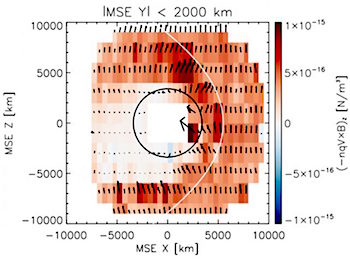 Mars, without a strong internal dipole magnetic field, is a place where the supersonic solar wind directly contacts the planet’s upper atmosphere. Using a large set of data from the Mars Atmosphere and Volatile EvolutioN (MAVEN) mission, [a paper published in the Journal of Geophysical Research–Space Physics examines] some properties of the solar wind in that interaction region, especially velocity distributions that might lead to plasma waves. The paper discusses this effect, plus provides a calculation of the large-scale force terms and their relationship to possible planetary ion loss. The conclusion isn’t surprising: the VxB “pick-up” force is largest and should dominate planetary ion loss. It’s nice to see the comparison with other terms in this robust combination of case studies and statistical analysis. [More at links]
Mars, without a strong internal dipole magnetic field, is a place where the supersonic solar wind directly contacts the planet’s upper atmosphere. Using a large set of data from the Mars Atmosphere and Volatile EvolutioN (MAVEN) mission, [a paper published in the Journal of Geophysical Research–Space Physics examines] some properties of the solar wind in that interaction region, especially velocity distributions that might lead to plasma waves. The paper discusses this effect, plus provides a calculation of the large-scale force terms and their relationship to possible planetary ion loss. The conclusion isn’t surprising: the VxB “pick-up” force is largest and should dominate planetary ion loss. It’s nice to see the comparison with other terms in this robust combination of case studies and statistical analysis. [More at links]
-
Recent Posts
Archives
Links
general
mission instruments
- CRISM: Compact Reconnaissance Imaging Spectrometer for Mars
- CTX: Context Camera
- HiRISE: High Resolution Imaging Science Experiment
- MARSIS: Mars Advanced Radar for Subsurface and Ionosphere Sounding
- SHARAD: Shallow Radar
- THEMIS: Thermal Emission Imaging System
missions
- All Mars missions list
- Curiosity rover
- ExoMars
- Hope (al-Amal) orbiter
- InSight
- Mars Atmosphere and Volatile Evolution Mission (MAVEN)
- Mars Exploration Rovers (MER)
- Mars Express (MEX)
- Mars Odyssey
- Mars Orbiter Mission (MOM) / Mangalyaan
- Mars Reconnaissance Orbiter (MRO)
- Mars Science Laboratory (MSL)
- Perseverance Rover
- Tianwen-1 orbiter/rover
news








